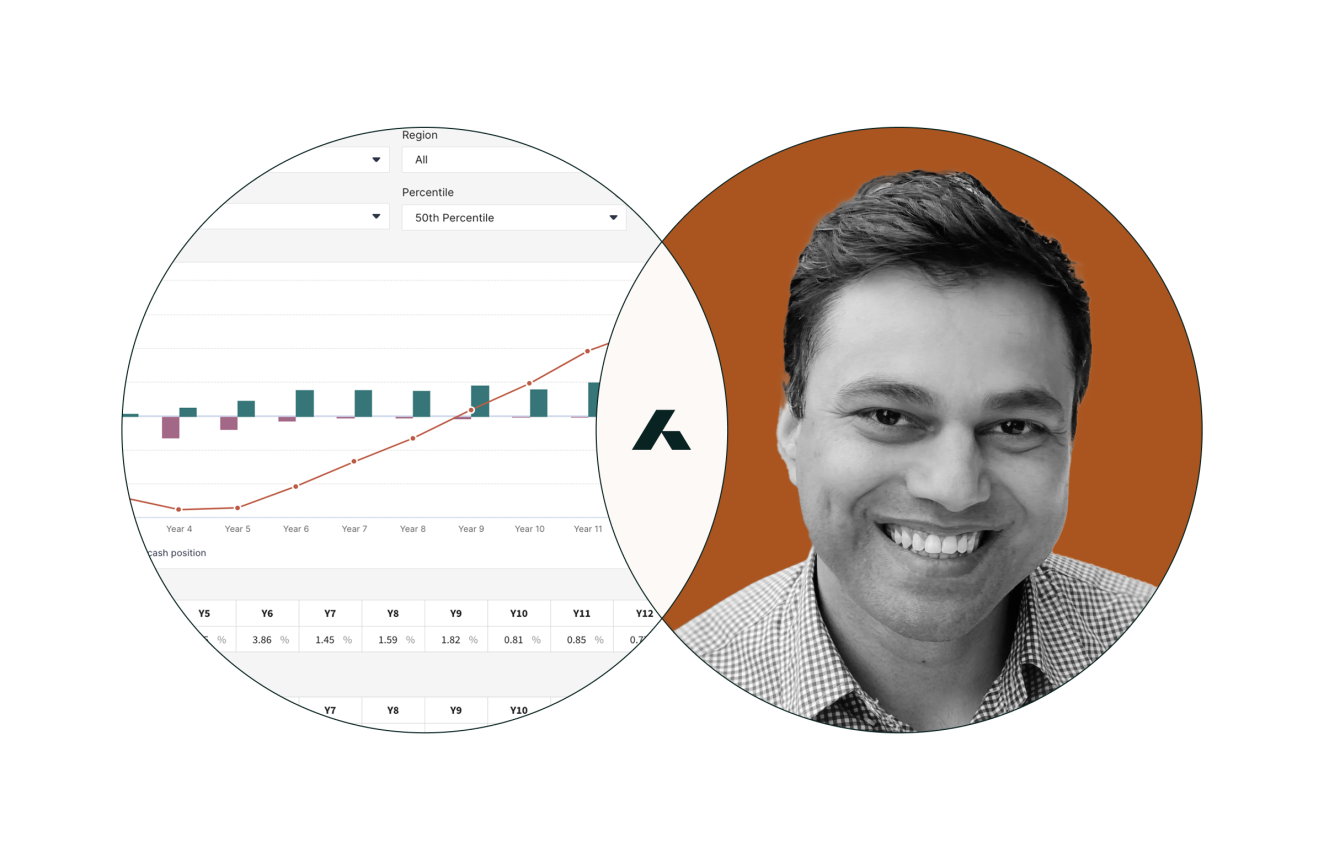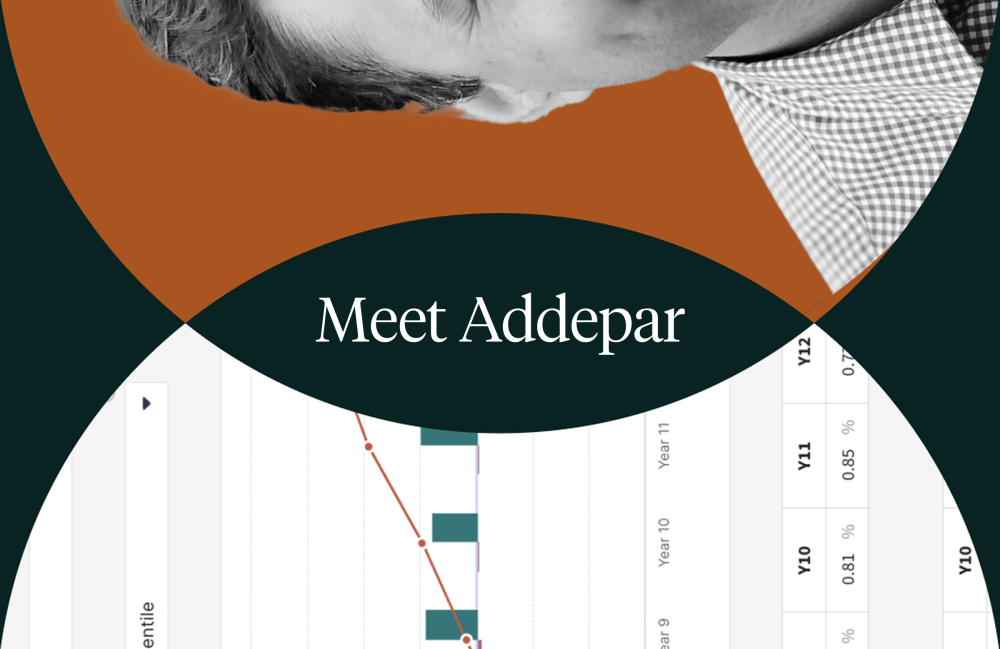Published on
In our Meet Addepar series, we sit down with the people at the heart of our success — those who enable us to consistently deliver excellent outcomes for our clients. Today, we speak to Rajiv Sharma, Director of Product Management for Addepar Navigator.
Rajiv guides product development for Navigator, our forward-looking portfolio projection solution. With an extensive background working with large institutional investors around the world, Rajiv draws on his industry expertise to lead Navigator’s ongoing expansion.

What is Addepar Navigator?
Addepar Navigator is our portfolio modeling and projection solution, purpose-built to simulate scenarios and forecast cash flows with your entire portfolio. It empowers all types of users — from large RIAs to family offices, global banks and institutions — to model future portfolio outcomes, forecast liquidity and test strategies across both public and private assets.
Can you tell us about your journey to becoming Director of Product Management for Navigator?
I have always been driven to solve problems and come up with solutions, which stems from my Engineering undergraduate days. I actually studied mechatronics engineering at Auckland University, which is a combination of mechanical, electrical and software programming — other alumni from the program went on to found self-driving car and wearable technology companies!
Following my undergraduate studies, I did a PhD looking at the role of large institutional investors like pension funds and sovereign wealth funds for financing long-term projects like infrastructure. It was during my PhD that I really started to understand how important asset owner institutional investors are, how they go about their decision making and how consequential their decisions are for the financial system and broader economy.
Interestingly, in my engineering studies, I investigated how machine learning algorithms can be used to help forecast stock market movements, particularly in smaller markets that are heavily impacted by large trading partner economies (making the training process easier). During my PhD, I had written about the structural ‘translucency’ of private market financial products, referencing infrastructure. Working at Addepar to help investors gain more transparency into their financial assets, including through forward-looking visibility on key metrics, is in some ways a full circle moment for me in my career!
What are some notable projects/initiatives you’ve undertaken in your previous roles?
I have devoted most of my professional career (other than a fledgling sporting career) to studying, understanding and advising some of the largest asset owner investors in the world.
One of the more notable projects I was involved in prior to Addepar was in fact writing a book (with co-founder of Navigator (formerly RCI), Ashby Monk), called Reframing Finance, which looks at how large institutional investors can overcome inefficiencies associated with investing in alternative assets. It put forward a model based on collaboration with peers and re-intermediating with aligned partners when deploying capital, vis-a-vis the Yale (Endowment) model or the Canadian direct investing model. This ‘collaborative model’ was adopted by the California State Teachers' Retirement System, the second largest pension fund in the country. As a result, they were able to save over $2 billion in fees since 2017. Its collaborative strategies outperformed its custom benchmark in 2024, as well as traditional fund investments over a ten-year horizon.
The collaborative model was also adopted in India when their government set up and implemented the National Investment and Infrastructure Fund (NIIF), a strategic sovereign fund, in 2016. The NIIF has grown to be the largest infrastructure investment vehicle in India. It has been hugely rewarding to see these strategies be implemented and the impact that they have made.
Can you talk us through Navigator — what challenges it aims to solve and the development process?
Navigator was developed to solve key workflow and analytical challenges institutional investors face. One of the key challenges investors expressed time and again was an inability to project the total portfolio into the future and reliably understand key metrics like liquidity, returns, allocations and cash flows. This exercise was predominantly being done in Excel, which led to a backlog of issues around data aggregation, consistency and scalability. Navigator seeks to solve these issues, enabling detailed modeling of alternative assets and improving portfolio projection, analysis and reporting workflows to ultimately drive better, more informed investment and risk management decision-making.
Since Navigator’s inception, we have been working to achieve product market fit across all types of investor clients for total portfolio projection analysis use cases. The Navigator team, like much of Addepar, brings together top-tier R&D talent from Silicon Valley and around the world. To ensure success, we set up processes for smoothly onboarding clients, and in collaboration with our GTM team, established a clear feedback loop with actual users to inform product development.
The integration of this technology has been synergistic, allowing investors to leverage the sophisticated modeling and configuration capabilities that Navigator provides — all within the broader Addepar platform.
What are some projects/initiatives you’ve overseen at Addepar?
Our product development process is based on having a good grasp of what the latest advancements are in industry and academia. We combine that with a close working relationship with our clients and our development is very much iterative based on a tight feedback loop. This ensures we’re continually innovating our offering.
There have been numerous examples of projects we have embarked on to bring innovation to our solution. One project we’ve worked on is the incorporation of historical J-curve data and visualizations. Navigator brings together capital market assumptions with portfolio data into a single source of truth to reliably project out key metrics for an investment portfolio. With Navigator, users can access Addepar’s extensive database of private fund cash flows to build assumptions for cash flow projections. This anonymized private fund database is one of the largest in the world, all representative of funds that our clients actually invest in. These assumptions can then be adapted to simulate different economic environments.
More recently, we released an optimization engine to assist sizing up commitments to alternative assets to reach target allocations. The optimizer provides recommended commitment amounts to achieve a target allocation over a given period of time, taking into account the assumptions across all asset classes in a portfolio plus investment and non-investment-related cash flows modeled. Users can select the commitment profile that best fits their pacing needs, and recommendations take into account their available liquidity, plus current and future portfolio activity.
Are there any client success stories that really stand out to you?
A couple of highlights include one multi-family office, Stone Temple Partners, who manage unique portfolios for investors — over 50% of which are allocated to private market investments. Before Navigator, legacy systems and spreadsheets created multiple challenges around visibility and flexibility. With Navigator, they’ve been able to model capital calls, distributions and liquidity timelines more easily and with greater precision and sophistication. They’ve since closed 10-20% allocation gaps to alternatives across portfolios. And even more impressively, achieved a 150 basis point return uplift. All the while, they reduced planning time by 90%.
Also, we’ve seen one of our pension fund clients use Navigator to fundamentally address the inefficiencies of portfolio data being used by different teams in different spreadsheets. They used Navigator to gain clarity on their cash positions, given their high exposure to alternatives. Driving high returns (and minimizing cash drag) is crucial for this pension fund to continue to pay out pensions to its beneficiaries. As a result of using Navigator, they’ve been able to reduce its cash holdings by at least $50 million and redirect the cash into higher return generating assets. For a pension that is nearly 50% illiquid, it has also helped the fund plan for raising cash, such as in the unexpected situation that occurred during COVID, when a spike in cash outflows was observed (a year’s worth occurring within a couple months). The strategic investment plan for this pension was rewritten based on this clarity on its cash positions now and into the future, which has ultimately translated into more conviction in the payments made to pensioners over the long run.
Driving these results for clients where our technology is uncovering insights that invoke changes to the portfolio and in turn, impact the underlying beneficiaries or principals in a positive way, is hugely rewarding.
What developments are you most looking forward to for 2025 and beyond?
We’re excited to provide an enhanced user experience so that users can complete their workflows as quickly and effectively as possible. This includes a modern UI and seamless integration across all areas of the platform, as well as incorporation of AI/machine learning to facilitate and complete analytics. Specifically, we will be looking to bolster our projection capabilities with newer methodologies for forecasting portfolio metrics under different macroeconomic conditions, bolster our optimization functionality and improve reporting flexibility.
We think these changes could spell even better outcomes for Navigator users. Together with other parts of the platform, they will broaden functionality around scenario analysis and allow for more effective decision-making and risk management. Specifically, I’d like to see the Addepar solution for ex-ante analysis be the go-to solution for all types of institutional investors to carry out their key analytical workflows. In this way, we hope to be able to maximize the impact of the world’s capital.
